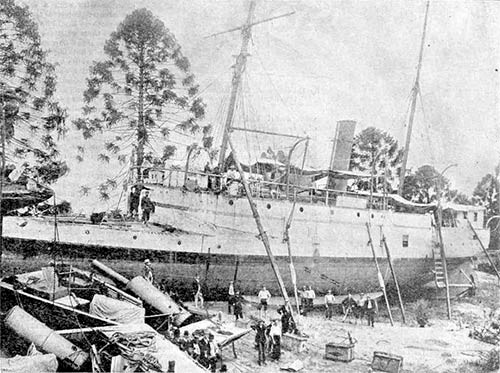Flooding in Queensland: The story of the Paluma
Bill Dennison ·The story of the naval survey ship Paluma that was cast up into the Botanic Gardens in February 1893 and refloated two weeks later is part of Brisbane lore, and I decided to track down the story about how the Paluma was refloated. I went to the Queensland State Library archive section and was impressed with the beautiful library and helpful staff. I found some great books and photos, but also found out that there is a web-based archive of newspaper articles and photos that the National Library of Australia supports called Trove.
The concept of having armed coastal ships was debated in Queensland Parliament because of the perceived threat of war between Britain and Russia in the early 1880s. Queenslanders noted that the British Royal Navy ships were rarely seen in Queensland waters and that Russia was building armed ships to deploy in Pacific Ocean waters. In Brisbane, the construction of Fort Lytton at the mouth of Brisbane River was initiated in 1880 to provide protection against invasion. In addition, the Queensland government commissioned the construction of two coastal steam powered vessels, the Paluma and Gayundah. These ships were built at Armstrong's shipyard at Newcastle on Tyne in 1884. Both ships were 120 feet long and had a 9.5 foot draught. They were heavily armed with six mounted guns. Therefore, the names of the ships were said to be Aboriginal words for thunder (Paluma) and lightning (Gayundah). They used coal as fuel and had a range of 700-800 miles. They carried as many as 50-60 crew.

The Paluma and Gayundah were launched in May 1884 and traveled to Australia via the Suez Canal. The Paluma arrived in Brisbane on 7 May 1885 and was converted to a coastal survey vessel and was based in Townsville for ten years surveying the coast from Cape York to the Whitsunday Islands.
Both the Paluma and the Gayundah were in the Brisbane River in February 1893. The Gayundah was able to ride out the flood in the Brisbane River, but the Paluma, under the command of Captain Pirie of the British Royal Navy was cast up into the Botanic Gardens along with two other ships, the S.S. Elamang and Miada on 5 February 1893. The Paluma was undergoing a refit and the boilers for the steamship were not operable, so the crew was at the mercy of the ten plus knot current once the hawsers connecting the Paluma to shore gave way. The tugboat Seahorse attempted to drag the Paluma back into the Brisbane River to no avail and as the floodwaters receded, the Paluma was left stranded.

Thousands of people came to visit the Botanic Gardens to view the Paluma after the flood waters subsided, and widely publicized photos were taken of the Paluma aground. The price that was quoted to refloat her was considerable, and the Premier of Queensland, Sir Samuel Griffith, delayed his decision. For once, dithering by political leaders paid off, because with additional rainfall, the Brisbane River began flooding again. The second flood was not quite as high but the water level rose to within five feet of the Paluma, allowing the Harbour Master, Captain Mackay, aboard the government steamer Advance to attach a wire to connect the two ships and alternatively steam full ahead and full astern to rock the Paluma loose. This refloating operation took place from Saturday morning 18 Feb 1893 until 3 am the following morning (19 Feb 1893). The Paluma was also winching in their kedge anchors placed in the Brisbane River.


HMAS Paluma was part of the Australian Naval Forces upon federation in 1901. Paluma ended up as a lighthouse tender S.S. Rip for the Port of Melbourne and was broken up and sold for scrap in the mid-1950s. Four ships have been named Paluma, as well as Paluma township in North Queensland, the Paluma Shoals in Halifax Bay and Paluma Range nearby.
The story and images of the Paluma in the Botanic Gardens during the 1893 should serve as a constant reminder to Queenslanders that they live in a flood prone region. The January 2011 flood was not the first flood in the region and it was far from being the largest flood. This year’s flood will not be the last flood either, and Queenslanders will need to work at being better prepared for future floods that are sure to come along.
References:
Argus, Melbourne newspaper. 9 February 1893.
Brisbane Courier, Brisbane newspaper. 8 February 1893.
Pixley, Norman S. 1946. The Queensland marine defence force. Paper presented at the meeting of the Queensland Royal Historical Society, Brisbane, November 1946.
The Queenslander, Brisbane newspaper. 11 February 1893.
The Queenslander, Brisbane newspaper. 25 February 1893.
Venn, Linda. 2002. Paluma: The first eighty years. 1870s-1950s. Thuringowa City Council
About the author
Bill Dennison

Dr. Bill Dennison is a Professor of Marine Science and Vice President for Science Application at the University of Maryland Center for Environmental Science.

